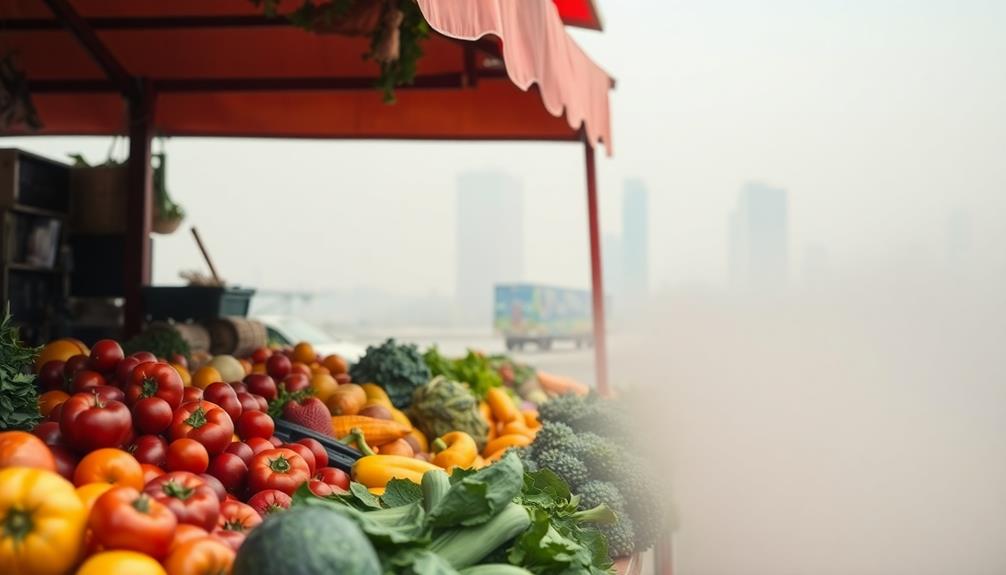Pollution silently infiltrates your plate, altering the flavors of the foods you eat in unexpected ways. Air pollutants can introduce off-flavors in crops, reducing their overall taste and nutrient content. Meanwhile, soil contaminants like heavy metals affect flavor development in fruits and vegetables, making them less appealing. Poor water quality can create musty tastes in fish due to harmful algae blooms. Even seasonal changes can shift flavor profiles, as environmental factors impact seafood and crop freshness. If you want to uncover more about how pollution impacts your food's taste and safety, keep exploring this topic further.
Key Takeaways
- Air pollutants can introduce off-flavors in foods, altering their flavor profiles and reducing quality.
- Soil contaminants accumulate in crops, leading to unpleasant tastes and decreased marketability.
- Poor water quality from pollutants can create musty or chemical tastes in fish and crops.
- Seasonal environmental changes can exacerbate off-flavors, especially in seafood during algal blooms.
- Heavy metals and organic pollutants in food sources negatively impact both taste and nutritional quality.
How Air Pollution Alters Taste
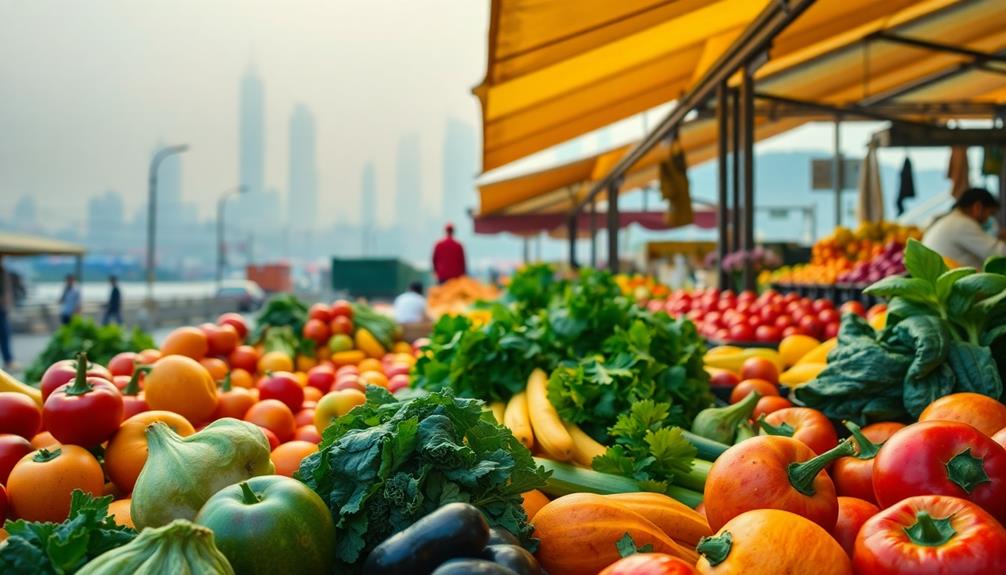
Air pollution not only affects the environment but also alters the taste of the food we consume. When you bite into an apple or enjoy a salad, you mightn't realize that pollutants like particulate matter and nitrogen oxides can change the flavor profile of these foods. Research shows that volatile organic compounds (VOCs) from industrial activities can introduce off-flavors, decreasing food quality and nutritional value.
For instance, just as traditional dishes like Muamba De Galinha rely on rich, untainted flavors, polluted air can compromise the essence of fresh ingredients.
Moreover, crops exposed to higher levels of ozone often experience reduced nutrient content, impacting your perception and acceptance of the food. Livestock isn't immune, either; they can develop health risks from polluted air, which may compromise the taste and safety of meat and dairy products due to bioaccumulation of harmful substances in their feed.
These changes raise significant concerns for public health and environmental sustainability. With altered crop yields and diminished flavor, the implications of air pollution extend beyond taste buds, affecting what you eat and the nutrients you receive.
Soil Contaminants and Flavor Changes
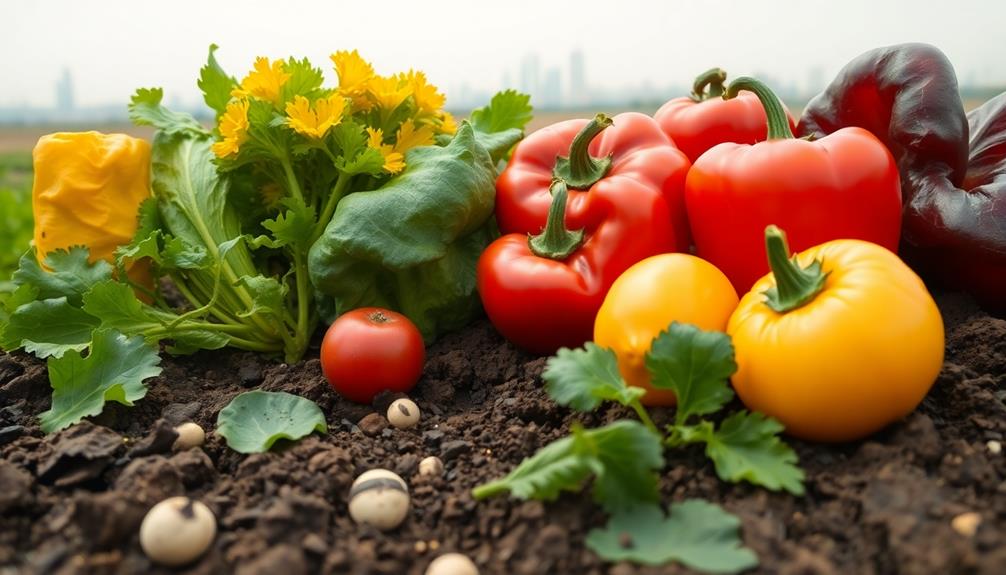
Soil contaminants can drastically change the flavor of the crops you eat, often without you even realizing it. Heavy metals, pesticides, and industrial chemicals infiltrate polluted soils and accumulate in plant tissues, leading to off-tastes.
These alterations pose significant health risks and affect consumer acceptance of fruits and vegetables, similar to how the richness of flavor in dishes like Red-Braised Pork Belly is essential for a satisfying meal.
Here are three major ways soil contaminants impact flavor profiles:
- Altered Flavor Development: Chemical residues from pollutants disrupt the natural processes that create aromatic compounds, essential for characteristic flavors in crops.
- Unpleasant Off-Tastes: Contaminants like lead, cadmium, and mercury can introduce earthy or musty flavors, detracting from the freshness you expect in your produce.
- Marketability Issues: The presence of undesirable flavors reduces overall quality, making crops less appealing to consumers and impacting their acceptance in the market.
When you choose your food, consider how soil contaminants might affect not just the safety of what you're eating but also the flavor experience.
Understanding these nuances can lead to more informed choices in the produce aisle, ensuring you get the quality and taste you deserve.
Water Quality's Role in Food Flavor
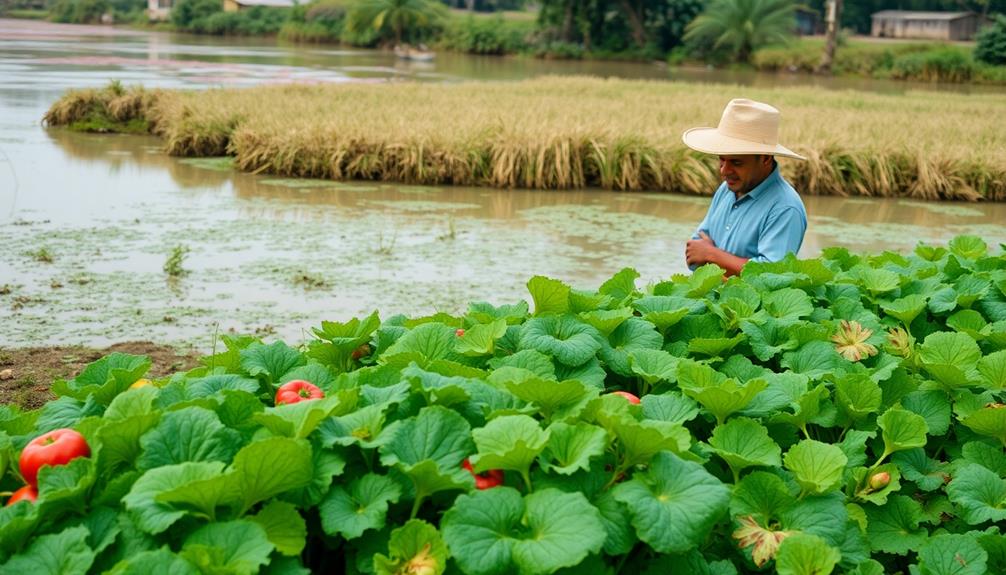
Clarity in water quality is crucial for the flavor of the food you consume. Poor water quality can introduce contaminants like heavy metals and pollutants that impart off-flavors to fish and crops. For instance, when algal blooms occur, they release compounds such as MIB and geosmin, creating earthy-musty tastes in fish and other aquatic organisms. This greatly impacts their flavor quality.
Additionally, the quality of water can affect the taste of certain traditional dishes, such as Dorayaki (Red Bean Pancake), where the purity of ingredients plays a crucial role in the end flavor.
In marine environments, you might notice iodine-like and chlorine-like off-flavors in fish sourced from polluted waters. Such alterations highlight the critical connection between water quality and seafood flavor. Stagnant or polluted waters often lead to off-tastes in fish due to enzymatic degradation and spoilage, emphasizing the necessity of clean water for maintaining flavor integrity.
Moreover, historical pollution from industrial discharges has permanently affected the flavor quality of seafood, raising public concerns and leading to fishing prohibitions in certain areas.
For your safety and enjoyment, it's crucial to recognize how water quality directly influences the food flavor you experience, particularly in fish and other aquatic products. Prioritizing food safety means being aware of where your food comes from and the conditions in which it was raised.
Impact of Chemical Pollutants
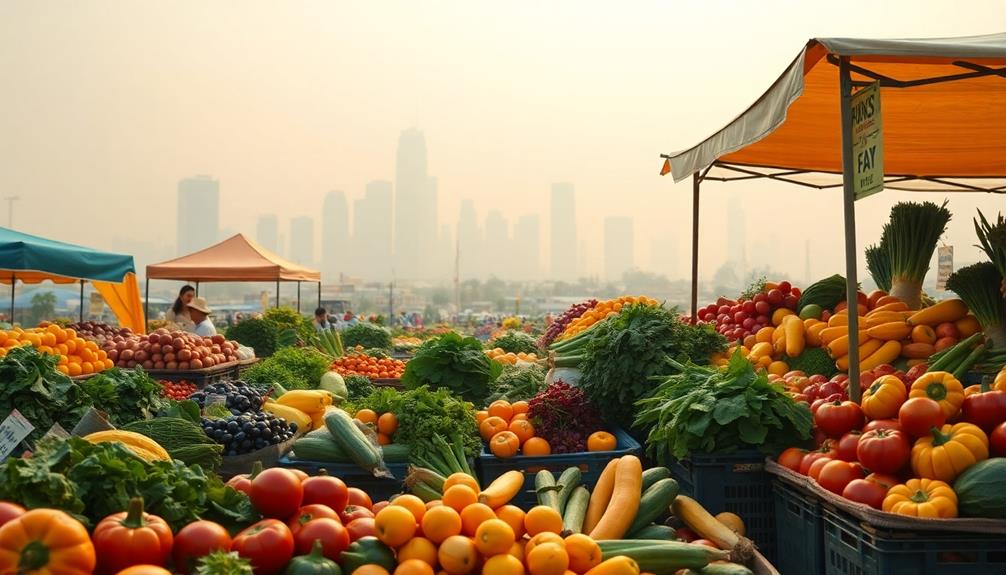
How do chemical pollutants change the foods we eat? The impact of these substances can be significant, altering flavor profiles and raising concerns about food safety and quality. For instance, certain foods served during festive occasions, such as Halloween-themed treats, might be affected by these pollutants, impacting their appeal and safety.
Here are three key ways that chemical pollutants affect our food:
- Altered Taste: Heavy metals and persistent organic pollutants can lead to off-tastes in crops and marine fish, making them less appealing to consumers. For instance, microcystins from harmful algal blooms can impart earthy flavors to freshwater fish, affecting their marketability.
- Nutritional Quality: Exposure to air pollutants like polycyclic aromatic hydrocarbons (PAHs) can change the chemical composition of crops, not only impacting their taste but also diminishing their nutritional quality.
- Chemical Contaminants: Seafood may develop undesirable flavors due to exposure to substances like styrene, which can leave a chemical taste. This underlines the urgent need for monitoring chemical levels in food production to guarantee safety.
These changes can have serious health effects, impacting not just your dining experience but also the broader implications for food production and consumer choices.
Seasonal Variations in Food Taste
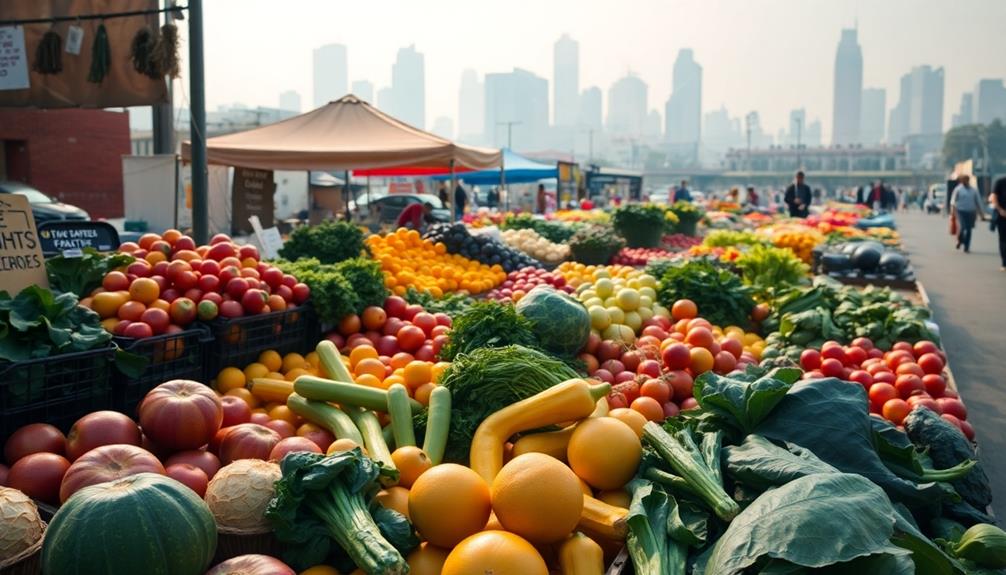
Seasonal variations can dramatically influence the taste of the foods you enjoy, particularly seafood. Environmental factors play a vital role in how flavors change throughout the year. For instance, during spring months, you might notice off-flavors in fish due to specific algal blooms and shifts in water quality. Freshwater algae, producing compounds like MIB and geosmin, can give fish an earthy-musty taste, often linked to seasonal temperature and nutrient dynamics.
In Brazilian cuisine, the freshness and quality of seafood dishes like Caldeirada can be considerably affected by these environmental changes.
In marine environments, some fish species, especially in places like the Baltic Sea, may develop iodine-like off-flavors during certain seasons. These changes reflect varying water conditions and impact the overall taste profiles of the seafood you consume.
Additionally, fluctuations in water temperature and nutrient availability can exacerbate harmful algal blooms, further affecting the flavors of aquatic food sources.
As a result, public concern about food consumption rises during these periods, leading to fishing prohibitions when off-flavors become pronounced. This connection emphasizes how seasonal variations not only alter taste but also raise health consequences and safety perceptions regarding our food choices.
Frequently Asked Questions
How Does Pollution Affect the Food We Eat?
Pollution affects the food you eat by introducing harmful chemicals into the soil and water. These contaminants can alter flavors, reduce nutritional quality, and lead to unsafe residues, ultimately impacting your overall health and dining experience.
What Are the Negative Effects of Food Pollution?
Food pollution negatively impacts your health and the environment. You might consume harmful chemicals, experience altered flavors, and face food safety risks. Contaminants can reduce nutritional quality, making your meals less enjoyable and potentially hazardous. Moreover, food pollution contributes to reasons for food poisoning susceptibility, as contaminated ingredients can harbor dangerous bacteria or viruses. This not only affects vulnerable populations but also increases the likelihood of widespread foodborne illnesses. Addressing this issue requires stricter regulations, sustainable practices, and increased consumer awareness to protect both health and the planet.
How Is Food Contaminated From Pollution?
You might think food contamination only comes from handling, but pollution seeps into soil and water, introducing harmful chemicals. These contaminants gather in crops and seafood, affecting both their safety and taste.
What Does Pollution Taste Like?
Pollution often leaves a distinct taste in your food. You might notice earthy, musty flavors in freshwater fish or iodine-like notes in seafood, all resulting from contaminants that interfere with the natural flavor profiles.
Conclusion
To sum up, pollution's impact on food flavor is more significant than you might think. For instance, studies show that air pollution can reduce the sweetness of fruits by up to 30%, making that juicy peach you love taste less appealing. As you savor your next meal, consider how factors like soil contaminants and water quality can alter flavors right on your plate. It's a reminder to appreciate the true essence of our food, free from pollution's influence.

